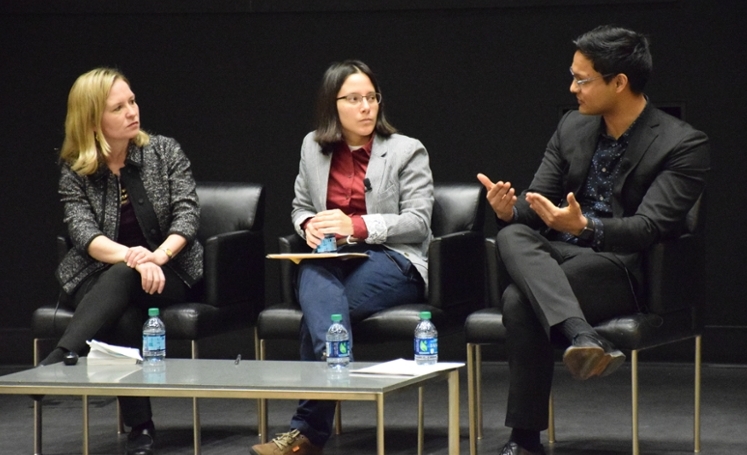How Turf Wars Lead to Violence in Chicago
Robert Vargas outlines how fights for control create crime hot spots
Get all our news

Robert Vargas discusses his findings on violence in the Little Village neighborhood with IPR psychobiologist Emma Adam (left) and Nicole Nguyen of the University of Illinois at Chicago.
Chicago’s Little Village ranks among the top 10 most violent neighborhoods in the city, with much of the violence concentrated on the neighborhood’s east side. As sociologist and former IPR graduate research assistant Robert Vargas (PhD '12) explains, these violent hot spots are due to a lack of resources and territorial disputes.
Vargas spoke at the inaugural Spencer Foundation Lecture on February 15, a new lecture series that seeks to bring together researchers from different Chicago-area institutions.

“Chicago is a city with vast intellectual riches around education scholarship, and we wanted to find ways to deepen the sense of community,” said Na’ilah Suad Nasir, president of the Spencer Foundation, in a statement.
Vargas was the ideal first speaker, according to IPR economist David Figlio, dean of the School of Education and Social Policy.
“What a remarkably wonderful way to start this series to have somebody who’s now an up-and-coming, extraordinary scholar at one of our local universities, who graduated from another local university, who’s made his career all about research about Chicago,” Figlio said.
Vargas, the Neubauer Family Assistant Professor of Sociology at the University of Chicago, outlined his case study of Little Village.
“I quickly learned that residents make spirited and courageous efforts to stop the violence on every block,” Vargas said, noting that he met individuals who worked with landlords to evict gang members, lobbied aldermen for resources, and called police to report gang activity.
However, just a half mile east, the picture was entirely different. Violence was much more common, Vargas said. Many residents wouldn’t even open their doors to the research team, and politicians were unresponsive.
These concentrated pockets of violence are the result of political and street turf wars, Vargas argues in his award-winning book, Wounded City: Violent Turf Wars in a Chicago Barrio (Oxford University Press, 2016). As he explained, relationships between political actors inside and outside the neighborhood shape a block’s capacity to acquire resources to prevent violence, while gang and police competition for the control of blocks can trigger shootings and arson.
Vargas referred to historical gerrymandering to illustrate the political turf wars. The west side of Little Village is in the city’s 22nd Ward, while the east side is split among three wards. The 22nd Ward has a history of strong political leaders who connected nonprofits with state agencies and foundations to secure grants for after-school programs, job programs, and violence-reduction interventions such as CeaseFire.
The east side, however, was divided after a white alderman feared the growing Latino population would force him out of office. Little Village’s east side residents now constitute less than 3 percent of voters in three different wards, meaning aldermen have little incentive to respond to their requests.
This lack of political responsiveness has severely undermined residents’ ability to acquire violence-prevention resources and led to residents resorting to direct ties with gang members to protect themselves.
Resisting the gangs by going to the police can trigger retaliation. Some gang members have police scanners and listen for informants’ addresses. Vargas related how a woman who reported gang activity lost her house in a fire started by a Molotov cocktail.
Police can also inadvertently trigger violence by breaking up gangs, opening up territory that other gangs attempt to claim. After the arrest of one local gang leader on drug changes, shootings spiked on the east side.
The multitude of battles going on in the neighborhood show how there is no easy solution to the violence problem, he said.
“We need a multi-pronged approach,” Vargas continued. “This pattern of violence being concentrated in politically disenfranchised, fragmented areas of the city is not unique to Little Village.”
Robert Vargas is the Neubauer Family Assistant Professor of Sociology at the University of Chicago and director of the Violence, Law, and Politics Lab.
Watch a video of the lecture.
Published: March 21, 2018.


